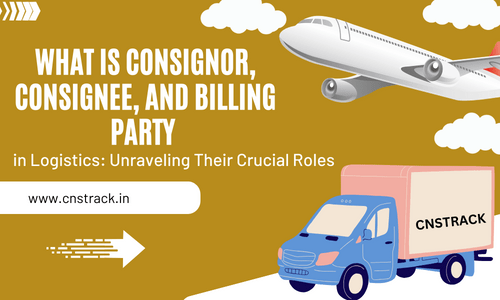What is consignor, Consignee, and Billing Party in Logistics: In the complex web of logistics and transportation, there are several key roles that ensure the smooth movement of goods from one point to another. Among these roles, the terms “Consignor,” “Consignee,” and “Billing Party” play pivotal roles. Understanding these terms is crucial for anyone involved in logistics or supply chain management, as they define the responsibilities and interactions of various stakeholders.
Consignor: The Material Provider
The term “Consignor” refers to the entity, whether it’s a company or an individual, that initiates the logistics process by providing goods or materials for dispatch. Essentially, the Consignor is the party that has something to send, and they are responsible for ensuring that the items are properly packaged, labeled, and ready for transportation.
For example, if a manufacturing company is shipping a batch of its products to a distributor, the manufacturing company is the Consignor in this scenario. They are the ones sending the goods out into the world, kicking off the logistics journey.
Consignee: The Material Recipient
On the other end of the logistics journey is the “Consignee.” This is the entity or person that receives the materials or goods that were dispatched by the Consignor. The Consignee is often the final destination for the shipment, and they play a crucial role in the supply chain by ensuring that the goods are received in good condition and put to use as intended.
Continuing with our example, the distributor receiving the products from the manufacturing company is the Consignee. They are the ones eagerly awaiting the shipment and will eventually distribute the products to retailers or end customers.
Billing Party: The Financial Facilitator
While the Consignor sends the materials, and the Consignee receives them, the “Billing Party” is the entity responsible for settling the financial aspects of the transportation. This can sometimes be the Consignor or the Consignee, but it can also be a third party entirely.
The Billing Party is tasked with paying for the freight and transportation services provided during the logistics process. They ensure that the logistics service provider, such as a shipping company, is compensated for their services. In some cases, a company may choose to handle the billing internally, while in others, they might outsource this function to a third-party logistics provider (3PL).
In essence, the Billing Party ensures that the financial transactions associated with the logistics operations are managed efficiently, contributing to the overall success of the supply chain.
The Interplay of Roles in Logistics
In many logistics operations, these roles can overlap or shift depending on the specific arrangements and agreements between the parties involved. For instance, the Consignor may also take on the role of the Billing Party if they are responsible for covering the shipping costs. Similarly, the Consignee may assume billing responsibilities if they are receiving goods on behalf of a customer and need to invoice them accordingly.
Why Clarity Matters in Logistics Terminology
In the world of logistics, clarity and precision in terminology are paramount. Misunderstandings or confusion regarding the roles of the Consignor, Consignee, and Billing Party can lead to logistical hiccups, financial disputes, and delays in the supply chain.
By grasping the distinct responsibilities of each of these parties, logistics professionals can streamline operations, reduce errors, and enhance the overall efficiency of the transportation process. Clarity in communication ensures that everyone involved in the logistics chain is on the same page, working together harmoniously to move goods from point A to point B.
In conclusion, the roles of Consignor, Consignee, and Billing Party are integral to the world of logistics. They define who sends, receives, and pays for the materials being transported. Understanding these roles and their interactions is essential for effective supply chain management and successful logistics operations.
